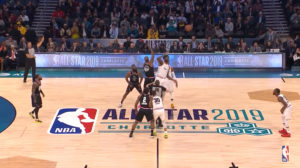 The Cleveland Cavaliers secured a victory against the Boston Celtics with a score of 115-111 on Sunday, a match that had the potential to be exhilarating. With just over three minutes remaining and the Cavaliers down by five points, Donovan Mitchell showcased his skills by scoring three consecutive 3-pointers and accumulating 11 points within a span of two minutes. All this has made a huge impact on odds in basketball betting at GG.BET. However, rather than concluding the game on an exhilarating note, spectators were instead subjected to the all-too-familiar and rather tedious finale of witnessing 17 free throws in the last 34 seconds, which extended the time to nearly half an hour.
The Cleveland Cavaliers secured a victory against the Boston Celtics with a score of 115-111 on Sunday, a match that had the potential to be exhilarating. With just over three minutes remaining and the Cavaliers down by five points, Donovan Mitchell showcased his skills by scoring three consecutive 3-pointers and accumulating 11 points within a span of two minutes. All this has made a huge impact on odds in basketball betting at GG.BET. However, rather than concluding the game on an exhilarating note, spectators were instead subjected to the all-too-familiar and rather tedious finale of witnessing 17 free throws in the last 34 seconds, which extended the time to nearly half an hour.
The most recent piece of evidence introduced in the case opposing conventional timed basketball endings supports the argument for the Elam Ending. This alternative format stops the running clock at the four-minute mark of the fourth quarter. Subsequently, the game continues until one team reaches a target score that is seven points higher than the current total of the leading team.
For example, if Team A holds a 104-100 advantage over Team B with four minutes remaining, the clock halts, and the objective shifts to achieving 111 points.
From an entertainment perspective, the decision is quite straightforward. It not only ensures a decisive game-winning shot but also significantly reduces any motivation for the trailing team to commit intentional fouls, as additional free throws would merely present the winning team with further opportunities to increase their score.
The Elam Ending has been showcased in two NBA All-Star games and has been a staple in The Basketball Tournament for several years. Jon Mugar, the tournament’s creator, articulated the rationale behind the Elam Ending to CBS Sports’ James Herbert before its debut in the NBA during the 2020 All-Star Game.
He explained that if Naismith had invented the basketball game 130 years before with this exclusive ending and someone would try to introduce a limited in time ending, experts would recognize it the most impressive failure of all times.
Ways For The NBA To Legislate End-of-game Fouling
Eliminating this issue would be quite straightforward. The league has effectively prohibited taking fouls, where defenders intentionally commit fouls to halt fast breaks, primarily for the sake of entertainment, and this decision was justified. Similarly, the league has taken significant steps against flopping, which is now penalized or, at the very least, not rewarded with consistency.
The next necessary adjustment should involve reinstating the game-tying three-pointer. Although we still witness these situations, coaches often exhibit a tendency to fear the worst-case scenario, particularly the possibility of a four-point play. However, those who can overcome their apprehension recognize that committing a foul (prior to the shot, of course) while holding a three-point lead in the final seconds is nearly always the most strategic choice from a competitive perspective.
The league must recognize that this approach is unwise. In a situation where there are fewer than 24 seconds remaining in a game that is within a three-point margin, committing a foul on the ball outside the three-point line—whether during a shot or while on the ground—results in three free throws being awarded.
If a foul occurs away from the ball and the existing “hack-a-player” regulations are manipulated to circumvent their intended purpose, the offensive team retains the option, similar to football, to decline the foul and instead take possession of the ball from out of bounds, foregoing the free throws.
Should a team commit two consecutive fouls away from the ball, this results in a technical foul, which entails one free throw and the opposing team gaining possession. Implementing these measures would effectively deter teams from committing fouls when leading by three points, thereby ensuring that fans are treated to the thrilling conclusions they rightfully expect for their investment.
How The NBA Can Fix This Problem
Basketball uniquely presents a scenario where actions typically viewed as detrimental to a team’s success, including fouls and missed free throws can, in critical moments of a game, actually serve to benefit the team. Comparing it with football, you can see the following: if a team is trailing by six points with only one second remaining, a defensive penalty does not prevent the offense from attempting one last pass to the end zone; it merely advances the offense closer to their goal.
Similarly, in soccer, when a foul occurs but the referee determines that the offending team has lost the advantage, the foul is acknowledged, yet play continues until a natural pause, thereby avoiding penalizing teams that have gained an upper hand and preserving the flow of the game.
This issue has long influenced basketball negatively, and it is imperative that it’s addressed. The Elam Ending could provide a comprehensive solution, but in the interim, the principle is straightforward: if a team is trailing by three points and has possession, they should be given the opportunity to equalize the score.
The NBA must ensure this occurs by imposing penalties for intentional fouls in the same manner as it does for take fouls. The conclusion of the recent Boston-Cleveland game was unacceptable, and the league should be ashamed of its slow response to this issue, as well as its reluctance to implement straightforward solutions.


